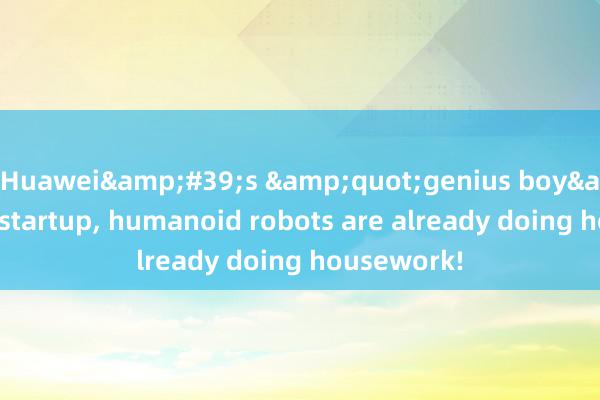
Huawei's "genius boy" startup, humanoid robots are already doing housework
On March 10, Zhiyuan Robot released its first universal embossed base model, Zhiyuan Qiyuan Module (GO-1, Genie Operator-1), and simultaneously announced that its universal embossed robot has been mass-produced and down-lined 1,000 units, covering industrial and commercial scenarios.
Zhiyuan Robot is headquartered in Zhangjiang Science City, Shanghai. Its co-founder and CTO (Chief Technology Officer) is Peng Zhihui, who was once known as Huawei's "genius boy".
Public information shows that Peng Zhihui was born in Ji'an, Jiangxi Province in 1993. After graduating from the School of Information and Communications of the University of Electronic Science and Technology of China in 2018, he later worked in the AI Laboratory of the OPPO Research Institute. In 2020, Peng Zhihui joined Huawei's team with the highest annual salary of 2.01 million yuan with the "Huawei Genius Youth Plan" and engaged in research related to Ascend AI chips and AI algorithms.
Peng Zhihui resigned from Huawei at the end of 2022 and co-founded Zhiyuan Robot in February 2023. In August of the same year, the first embossed intelligent robot "Expedition A1" developed by Peng Zhihui and his team completed its first public debut. In January 2024, Zhiyuan Robot and Peking University established a joint laboratory to focus on solving key embodied intelligent technology problems.
Ren Guanghui, executive director of Zhiyuan Embodied Research Center, mentioned that embodied models still face four major difficulties in implementing them. First, the generalization of existing embodied models is relatively poor. For example, in the past, the model was trained in the laboratory, and the success rate of a new scenario would drop significantly; second, the expansion of new tasks still faces challenges, that is, after training a new task, and wanting to do other tasks, it requires a large amount of data, which will be very high; third, the data cannot be shared in different ontology data, which also leads to relatively high data costs. For example, Zhiyuan Company has multiple ontology, but when different ontology adapt to different scenarios, the data is difficult to share, resulting in high costs; fourth, it is difficult to form a complete data reflow system, just like in autonomous driving scenarios, if the model cannot evolve from the reflowed data, it will lead to the failure of the model to continuously improve performance.
Now, through open source, robots are moving towards universalization, no longer performing a single task, but can collaborate with multiple tasks, and can also move from closed scenarios to open worlds, no longer limited to laboratories; most of the previous generation of robots have preset some programs, and now robots are increasingly able to understand human instructions. The release of this big model can also accelerate the popularization of embodied intelligence.
The GO-1 model released this time, with the help of humans and a variety of robot data, allows robots to gain revolutionary learning ability, and can be generalized and applied to various environments and objects, quickly adapt to new tasks and learn new skills. At the same time, it also supports deployment to different robot bodies, efficiently implementing, and continuously and rapidly evolving in actual use.
TheGO-1 model will accelerate the popularization of embodied intelligence and promote robots to develop from tools that rely on specific tasks to autonomous entities with general intelligence, and play a greater role in many fields such as business, industry, and family.
Ren Guanghui said that it will take about 5 years for humanoid robots to enter the home market, and the price may be at the level of 50,000 yuan. However, for each scenario, every user and task, the robot needs a lot of abilities, and the product forms are also different. However, scenarios such as serving tea and pouring water and making breakfast, currently, investments of thousands to 10,000 yuan can be achieved in the home scenario at the software system capabilities level.
Southern+Reporter Gao Xiaoping
